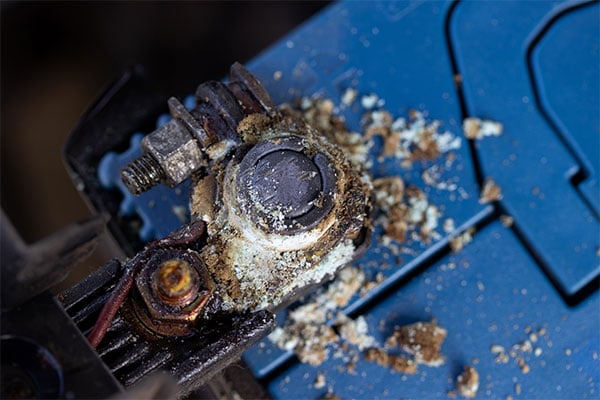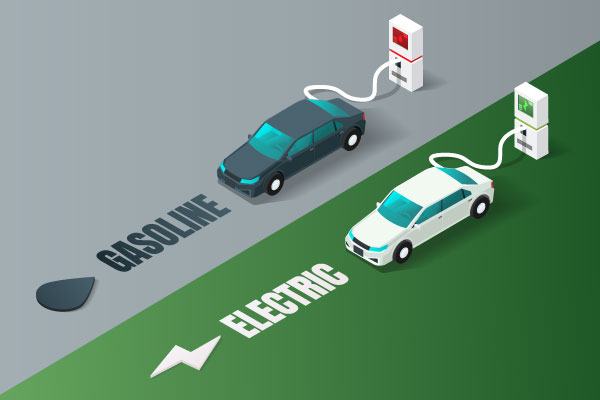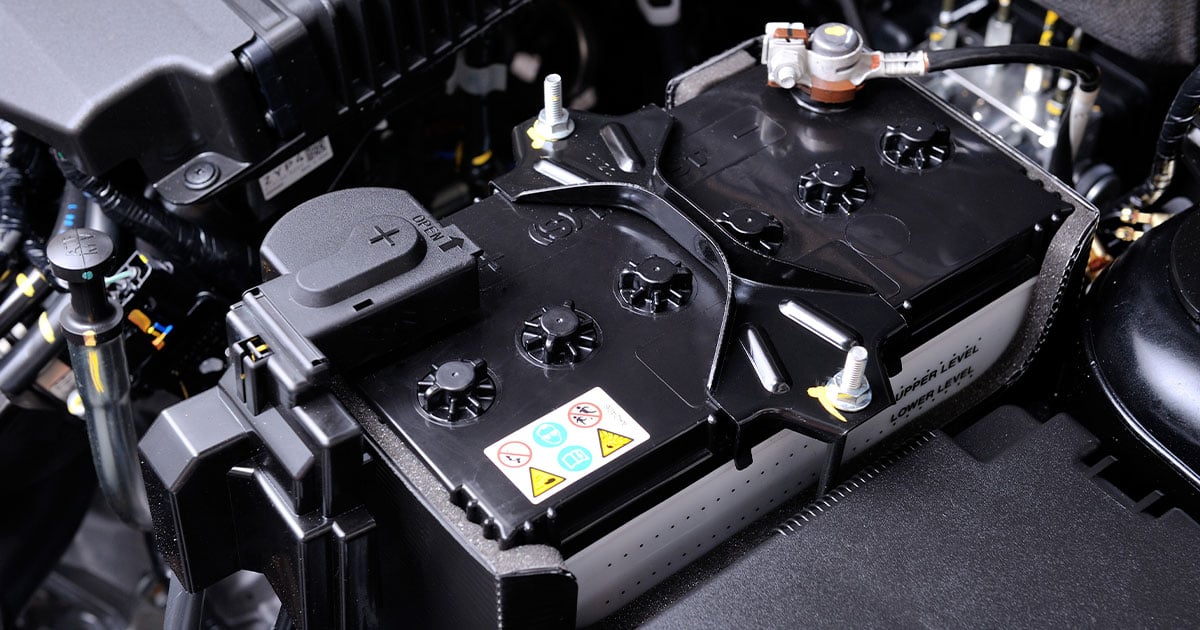Certain items can slip through the cracks when you’re trying to keep your vehicle maintained for the long haul. For some, car batteries are no exception, despite playing a pivotal role in your car’s ability to function.
Part of the issue is that a car battery replacement is a reactive service that occurs after your existing battery dies, rather than being proactive like oil changes, tires, or brakes. Without knowing the signs of a dying battery or other important facts, you’re more likely to have your car battery die unexpectedly instead of preventing it in the first place.
If you’re looking for answers to some common car battery questions (plus a few curveballs), we’re here to help cover the gamut so you can avoid the frustration of a dead battery.
How long does a car battery last?
One of the most important things about your car battery is how long it lasts. And yet, according to AAA, there is no set life expectancy for a new battery. The general rule of thumb is that it can last between three and five years, but the total lifespan varies based on multiple factors, including climate and usage.
Suppose you’re reading this from somewhere in the southern United States or anywhere in the world with a subtropical or arid climate. In that case, your car battery is likely to be replaced sooner than someone in a cold-weather region. You may not think the difference would be significant, but car batteries in hotter locales only last about three years, compared to five or more years in a colder area.
Regardless of where you live, it’s essential to consider replacing your car battery after the first three years are up. Local mechanics offer free battery testing to ensure it’s working correctly before potentially recommending a replacement. By being proactive and checking in with your car’s battery, you can avoid the inconvenience of needing to use your vehicle only to find out the battery has unexpectedly died.

How long can a car battery last without driving?
Even if you live somewhere cooler, your car battery can die earlier than expected due to how you use your vehicle. Or, rather, how you don’t use it.
That’s right; your car battery is susceptible to dying from a complete lack of use. While not uncommon, it was an issue made worse by the COVID-19 pandemic, which resulted in a surge in dead car batteries from people staying home and letting their vehicles sit for too long.
According to Nationwide, the standard car battery can last about four weeks without driving. Before you let your vehicle sit that long, it’s important to understand that the actual length of time will vary depending on the age of your car and battery. That time frame can be shortened by hotter temperatures, making it crucial to start your vehicle routinely if you live somewhere warm.
The leading cause of dead batteries from a lack of use can be attributed to lead sulfate crystals, which naturally form from lead-acid car batteries. Lead sulfate crystals will form naturally when you drive before dispersing in between uses. While these crystals are a standard reaction from using your car, they are made worse by too little use and higher temperatures.
If your car battery dies from a lack of use, it was very likely to have formed lead sulfate crystals that hardened to the point where your battery has a reduced capacity. That may mean it struggles to start or can’t hold a full charge, or it can be a sign that the battery cannot function at all.
Do EVs have different batteries than gas-powered vehicles?
As EVs - hybrids, plug-in hybrids, and all-electric vehicles - become more mainstream, many drivers are curious about the mechanical differences from a car with an internal combustion engine (ICE). And with good reason, there are some crucial differences beyond how each vehicle is powered.
When you dig deep under the hood, you’ll see that EVs and ICE vehicles rely on different types of car batteries. As previously mentioned, ICE models use lead-acid batteries, while EVs rely on lithium-ion batteries, commonly used in electronics like smartphones and laptops.

Lithium-ion batteries are more energy-dense than lead-acid, prolonging the overall lifespan and ensuring greater energy efficiency. They also have a higher performance in higher temperatures than lead-acid batteries.
An added benefit of EVs and lithium-ion batteries is that they have a much more extended warranty period than most batteries. Federal regulations require automakers to have a minimum warranty period of 8-years or 100,000 miles (whichever comes first). On the other hand, a lead-acid battery is only covered for five years at most.
What are signs your car needs a new battery?
If your car battery has been kicking for a couple of years, it may already be on its last legs. Fortunately, there are a few identifiable signs to look out for before it’s completely dead.
- Struggles to start: This sign is the most common and obvious, but it’s easy to ignore. If you notice that your car is taking too long to crank and start, your first guess should be that you need a new battery.
- Check engine light: Another common sign is the presence of your check engine light. If the voltage provided by your battery is too low, that light will illuminate as a goal-line defense before it finally dies.
- Battery corrosion: This one is tricky to tell since it requires a look under the hood. If you notice any crusty-looking substances on the + and - ends of the battery, then your battery is likely leaking and needs to be replaced.
These warning signs work in conjunction with your battery’s age to inform whether or not you need a new battery. It would be best if you didn’t ignore them, lest you be forced to handle the frustrations of a dead battery that needs to be replaced.
Can I install a new car battery myself?
It’s entirely possible to replace your car battery on your own, as plenty of vehicle owners can attest. Whether you take pride in doing things yourself or just like getting your hands dirty, installing your own replacement battery isn’t rocket science. It does, however, require some effort that most drivers aren’t willing to endure.
Before you begin, it’s essential to make sure that your car’s engine is cool enough for you to work without the risk of burns. Assuming that the engine is cool and you have a replacement ready to go, then the process of replacing your car’s battery is surprisingly straightforward.
Removing Your Battery
- Before starting, ensure that you have appropriate work gloves and a socket wrench with 8, 10, and 12mm sockets handy.
- Pop the hood, locate your battery, and identify the positive and negative terminals. (Note: the positive terminal has a red plastic cover)
- Using the socket wrench, loosen the nut on the negative terminal first to detach its cable from the battery, ensuring it’s not touching the battery.
- Repeat the process for the positive terminal.
- Remove the bolts and any clamps or fasteners keeping the old battery secured, and pull it out from its handle. (Note: your vehicle battery is heavy, so use precaution when removing yours.)
Installing the New Battery
- Ensure all parts under the hood are dry before continuing with the installation.
- Secure the new battery into place and remove the terminal covers. If you have an anti-corrosion solution, such as Permatex, spray it onto the terminals to prevent corrosion from forming over time.
- Attach the positive cable to the positive terminal and secure it with the socket wrench.
- Repeat step 9 with the negative terminal, and confirm that both terminals are secured.
- Cover the positive terminal with the red plastic cover and close the hood.
- Start the engine to test the new battery.

Can I recycle my used battery?
Once you’ve completed the replacement process, you may wonder what to do with the old battery. Since you likely have a used lead-acid battery, you must dispose of it properly. Both lead and acid are hazardous materials that can lead to serious environmental issues if handled irresponsibly.
Fortunately, the vast majority of vehicle batteries are recycled to keep them out of landfills. Your local municipality is likely to offer battery recycling at waste management facilities, which can take the used battery off your hands with ease. You can also bring your old battery to your local AutoZone and get a gift card for the trouble!
Drive Confidently with Convenient Battery Replacement Services
You can’t go wrong with pursuing maximum convenience as you look to get your car battery replaced.
Our team at Spiffy is eager to expand our mobile car care services to include battery replacements for our customers. Stay tuned to our website and social media channels to learn when this exciting service is available near you!





